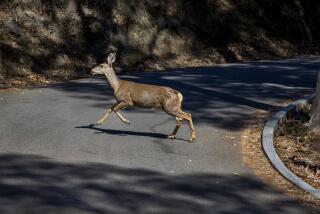BOOK REVIEW : Author Looks at Search for Religion in Great Outdoors
- Share via
Catherine Albanese argues that “nature religion,” not Christianity, has been the religious center of America culture.
Albanese, a respected UC Santa Barbara professor, tries to shake the word “religion “ loose from lifeless Sunday pieties. She fights the common belief that ours is a “secular society.” She agrees that the old channels through which spiritual ferment used to express itself--the churches and synagogues, the anthropomorphic religions--have silted up. Yet Albanese would show American society only superficially secular: the “search for the Sacred refuses to go away.”
Since the days of Emerson and Thoreau, many have insisted that Americans were more likely to reach the awe-filled, renewing experience of the Sacred while walking along the ridges of our mountains than sitting in a pew on Sunday; that America’s true shrine is not the Crystal Cathedral but the Grand Canyon; that Christmas may now be a shopping spree and Easter a spring break--but to see a spiritual reaction come over an American face, mention Yosemite, mention the redwood forests. “Heaven knows that John the Baptist was not more eager to get all his fellow sinners into the Jordan,” John Muir wrote, “than I to baptize all of mine in the beauty of God’s mountains.”
In Albanese’s pages, Emerson, Thoreau and John Muir emerge as the church fathers of America’s living religion. Muir “steeped himself” in Emerson and Thoreau, then translated their philosophy into the Church Militant. Muir, the father of our national park system and the Sierra Club, was a conscious theologian who pictured himself as a new “John the Baptist eating Douglass Squirrels & wild honey or wild anything” descending from “the divine wilderness” to “preach the green brown woods to all the juiceless world . . . crying, Repent for the Kingdom of Sequoia is at hand.”
Albanese suggests roots for this American religion in the Algonkian Indian religions that the first New England settlers encountered. She uncovers lively American nature religions in herbalism, hypnotic healing, homeopathy, the “spiral dance” of San Francisco witches celebrating The Old Religion of the Goddess and in the 1850 Davy Crockett Almanac’s joyous identification with the powers of nature: “I can walk like an ox, swim like an eel . . . spout like an earthquake, make love like a mad bull. . . .”
Albanese has the gift of being able to bring out the significance in virtually anything, and she writes beautifully about the oddest topics. My only reservation concerns her decision to approach contemporary American amateur physicians purely as a religious phenomenon, never asking for documentation of “cures.”
Albanese’s important work puts the 1990s’ religious ferment in perspective. She helps us understand what overtook Americans, almost to our own surprise, on the 20th anniversary of what may become a great religious festival, Earth Day: our feelings of reverence for the sacredness of the Earth.
NATURE RELIGION IN AMERICA
From the Algonkian Indians
to the New Age
by Catherine Albanese University of Chicago Press
$24.95, 240 pages


